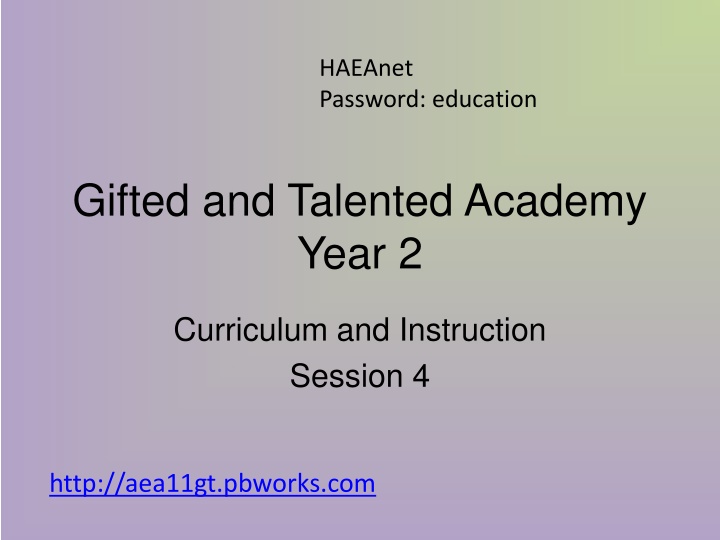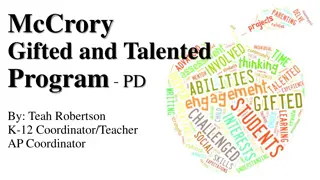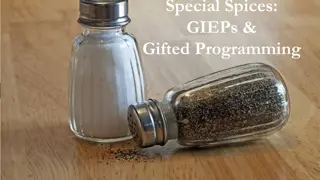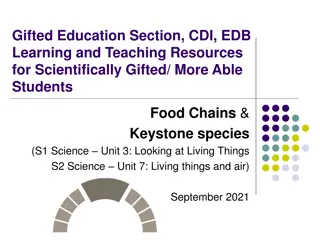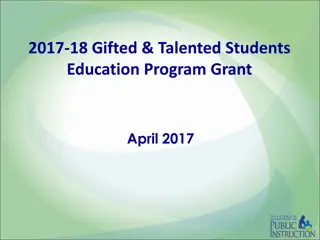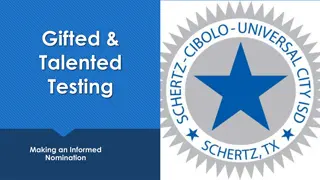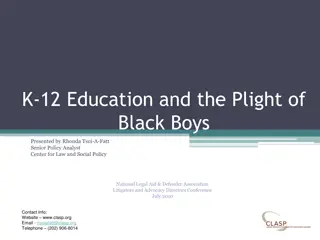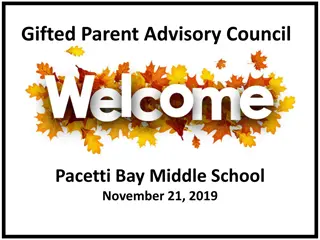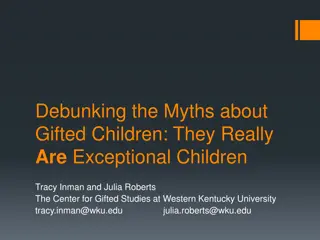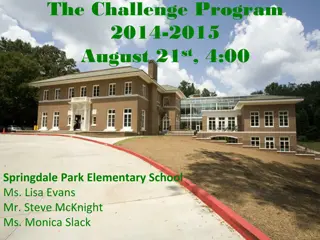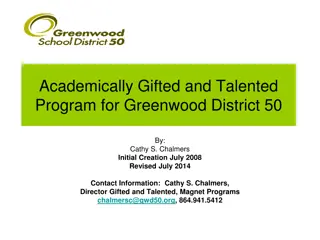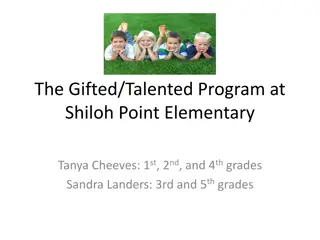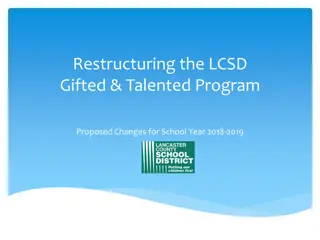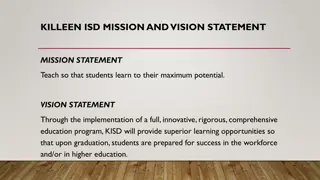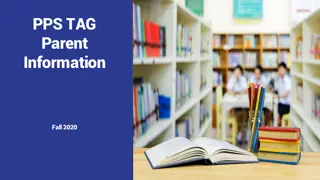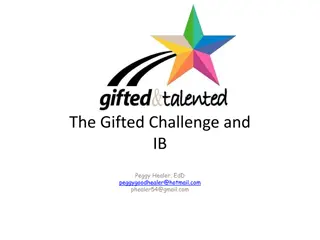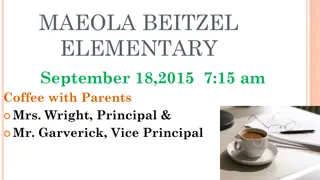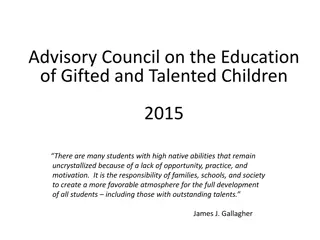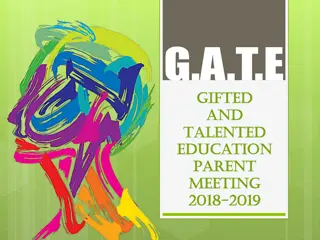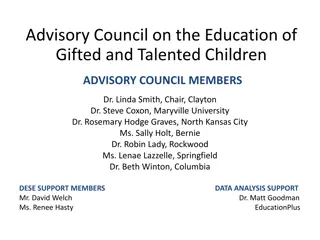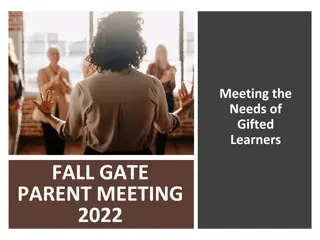Enhancing Gifted Education Curriculum Strategies
Explore curriculum management, instructional strategies, and program evaluation in gifted education. Learn how to improve services for gifted students through curriculum development and instruction. Engage in reflective practices and collaborative learning experiences to optimize educational outcomes.
Download Presentation

Please find below an Image/Link to download the presentation.
The content on the website is provided AS IS for your information and personal use only. It may not be sold, licensed, or shared on other websites without obtaining consent from the author.If you encounter any issues during the download, it is possible that the publisher has removed the file from their server.
You are allowed to download the files provided on this website for personal or commercial use, subject to the condition that they are used lawfully. All files are the property of their respective owners.
The content on the website is provided AS IS for your information and personal use only. It may not be sold, licensed, or shared on other websites without obtaining consent from the author.
E N D
Presentation Transcript
HAEAnet Password: education Gifted and Talented Academy Year 2 Curriculum and Instruction Session 4 http://aea11gt.pbworks.com
Agenda Welcome/Check In Important learning Curriculum Management Strategies Implementing Curricula for the Gifted Assessing Curriculum Team Time Sharing/Closure
Gifted Academy III Foci Using data Program evaluation Dates tbd Credits 2 Strand Administration
Academy 2: So What? Individually jot down the three most important pieces of learning for you Share with a partner Identify how you ll use this learning to improve services for gifted kids.
Linking Beginning and End Academy Outcomes Learn the components of a curriculum framework for gifted and talented Learn research- supported instructional strategies for gifted and talented learners Identify curricular and instructional matches based on student identification data Submit Curriculum/program documents developed; e.g., curriculum framework, scope & sequence Unit developed Team reflection addressing what was accomplished, how that represents an improvement in programming and services, the impact on other areas of the program (e.g., PD), as well as next steps for continuous improvement.
Home Play Continue curriculum development work. Read Chapters 10-12 in Curriculum Planning & Instructional Design for Gifted Learners Complete Appendix B to Chapter 12 (p. 247-55 for the curriculum you ve worked on today
Tuning Protocol Presenting teacher gives a summary of the unit developed including how it is adjusted for gifted. Share where you d like the group to focus its comments and suggestions. (4 minutes) Group asks clarifying questions. (4 minutes) Group has discussion about the unit. Presenting teacher does not participate. (4 minutes) Presenting teacher asks questions of group. (3 minutes) Presenting teacher summarizes and reflects. (3 minutes)
THE FIVE Cs Learning is the opposite of boredom. Learning is the antidote to boredom. 5 factors distinguishing boring from learning experiences: Control Choice Challenge Complexity Caring teachers
Chapter 59 59.5(2) Development of curriculum and instructional strategies. The program of instruction shall consist of content and teaching strategies that reflect the accelerative pace, intellectual processes and creative abilities that characterize gifted and talented students. A linkage between the selection of students, the anticipated student outcomes and the special instructional programs shall be evident. Learning activities shall provide for the development of skills which are beyond the scope of the regular classroom, introduce advanced concepts and contents, and offer students a greater latitude of inquiry than would be possible without the specialized instructional program. Specialized instructional activities shall be those not ordinarily found in the regular school program and may include, but shall not be limited to: a. A special curriculum supplementing the regular curriculum, using a high level of cognitive and affective concepts and processes. b. Flexible instructional arrangements such as special classes, seminars, resource rooms, independent study, student internships, mentorships, research field trips, and research centers.
1. The program of instruction shall consist of content and teaching strategies that reflect the accelerative pace, intellectual processes and creative abilities that characterize gifted and talented students. 2. A linkage between the selection of students, the anticipated student outcomes and the special instructional programs shall be evident. 3. Learning activities shall provide for the development of skills which are beyond the scope of the regular classroom, introduce advanced concepts and contents, and offer students a greater latitude of inquiry than would be possible without the specialized instructional program. 4. Specialized instructional activities shall be those not ordinarily found in the regular school program
Sense-Making Work with your team/table Chart paper Envelope with cards Tape Markers Lay out components of Ch. 59 Place other cards to create matches Add your own practices (blank cards) Identify gaps
The Key Chapter 59 Curriculum Assumptions NAGC Guiding Principles Learner Outcomes (Ch. 7) Activities and Resources (Ch. 8) Instructional Strategies (Ch. 9)
Curriculum Management Consider questions on p. 202 Select the one you d most like to discuss Move to that group Discuss Jigsaw Share w/large group
Implementing Curriculum One envelope per person Meet in like color groups Discuss the cards referring to the chapter as needed Form mixed color groups of four Each person randomly chooses a card Discuss connections, patterns, relationships Summarize the set on a sticky note Repeat When finished, develop non-linguistic representation of discussion. Large group sharing
NAGC-CEC Teacher Knowledge and Skill Standards for GT Education 10 Standards Comprised of knowledge and skills Two books Self-assessment Read standards four and seven and discuss with your team to develop common understanding Individually choose the number that indicates your own status relative to the K or S As a team, complete another form to indicate the status in your building/district relative to K or S.
NAGC-CEC Teacher Knowledge and Skill Standards for GT Education Discuss Strengths and needs What this means for your work
Team Time Assemble documents to be submitted Work on team reflection Summarize your accomplishments this year Identify next steps Share with large group
Home Play Put finishing touches on required submissions Share with Mary by April 30 Google docs
